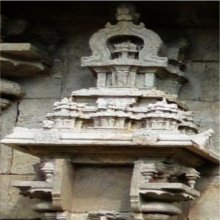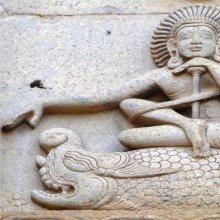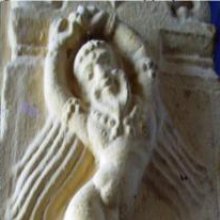Tirunelveli, Tirunelvēli: 2 definitions
Introduction:
Tirunelveli means something in Hinduism, Sanskrit, the history of ancient India, Tamil. If you want to know the exact meaning, history, etymology or English translation of this term then check out the descriptions on this page. Add your comment or reference to a book if you want to contribute to this summary article.
Images (photo gallery)
In Hinduism
Shaivism (Shaiva philosophy)
Source: DSpace at Pondicherry: Siddha Cult in Tamilnadu (shaivism)Inscriptions of Tirunelveli district, Tamiḻnādu.—A pair of Tamiḻ inscriptions dated 1253 C.E., found in the Nellaiyappar temple of Tirunelveli belongs to the 15th regnal year the Sundarapāṇḍiya speaks about the donation of lands to a tradition of Tapasis (ascetics). Though these two inscriptions are not directly referring to the Siddha cult in those regions, the contents of them indicate the existence Siddha cult during that period.

Shaiva (शैव, śaiva) or Shaivism (śaivism) represents a tradition of Hinduism worshiping Shiva as the supreme being. Closely related to Shaktism, Shaiva literature includes a range of scriptures, including Tantras, while the root of this tradition may be traced back to the ancient Vedas.
India history and geography
Source: Shodhganga: The significance of the mūla-beras (history)Tirunelveli is the place where Nellaiappar Temple is located, representing a sacred place for the worship of Śiva.—The city of Tirunelveli is situated near the river Tambarabarani, which is the source of the agricultural wealth of the southern districts of Tamilnadu. Tirunelveli is one of the eighteen Tirupathis of the Pandya land. Some of the other names of the sthala are Venu Vanam, Nelveli, Nellur, Saliveli, Salivadi, Salinagar, Brahmā Vṛdhapuram and Tārukāvanam.
The sthala-purāṇa says that a Brahmin, Veda Sanman by name, had spread the paddy on the floor for drying up. There was flood in the place. It was then that Lord Śiva raised a fence around the paddy that was stored for the worship of Siva. He protected the granary from the floods. Hence, the place got the name Tirunelveli. The term tiru means “holy,” nel means “paddy” and veli means “fence.” It is also said that the name is derived from the fact that the sthala is surrounded by fertile paddy fields on all sides. The names of the lord in Tirunelveli are Nellaiappar, Venuvananāthar, Nelvelināthar, Salivatisar, and Veymutha Nāthar. The goddess is called Kāntimati Amman and Vadivudai Amman. The inscriptions refer to the lord as Tirunelveli Udayār and the goddess as Tirukāmakoṭṭam Udayanāciyār.

The history of India traces the identification of countries, villages, towns and other regions of India, as well as mythology, zoology, royal dynasties, rulers, tribes, local festivities and traditions and regional languages. Ancient India enjoyed religious freedom and encourages the path of Dharma, a concept common to Buddhism, Hinduism, and Jainism.
See also (Relevant definitions)
Partial matches: Tiru, Nel, Veli, Nelveli.
Starts with: Tirunelveli Udaiyan, Tirunelvelicenna.
Full-text (+37): Tamraparni, Tirunelveli Udaiyan, Venu-vanam, Saliveli, Nelveli, Nellur, Salivadi, Salinagar, Tarukavanam, Aram Uraitha Peruman, Kayalpattanam, Kurichchi, Tirunatta, Nellaiyappar, Tamalakartika, Tavaperuman, Anabayan, Tirugnana Sambhandan, Porramarai, Niraiyangai Aduvan.
Relevant text
Search found 15 books and stories containing Tirunelveli, Tirunelvēli, Tiru-nel-vēli, Tiru-nel-veli, Tirunel-vēli, Tirunel-veli, Tiru-nelvēli, Tiru-nelveli; (plurals include: Tirunelvelis, Tirunelvēlis, vēlis, velis, nelvēlis, nelvelis). You can also click to the full overview containing English textual excerpts. Below are direct links for the most relevant articles:
Middle Chola Temples (by S. R. Balasubrahmanyam)
Temples in Gangaikondan < [Chapter II - Temples of Rajaraja I’s Time]
Temples in Pasuvandanai < [Chapter II - Temples of Rajaraja I’s Time]
Temples in Tirunelveli < [Chapter II - Temples of Rajaraja I’s Time]
Later Chola Temples (by S. R. Balasubrahmanyam)
Temples in Tiruvalangadu < [Chapter II - Temples of Kulottunga I’s Time]
Early Chola Temples (by S. R. Balasubrahmanyam)
Part II, Bronzes < [Chapter XI - Sculpture]
Kashyapa Shilpa-shastra (study) (by K. Vidyuta)
3. Conclusion (Gopuras) < [Chapter 6 - Conclusion]
Sanskrit sources of Kerala history (by Suma Parappattoli)
7. The Subhagasandesa by Narayana < [Chapter 4 - Traces of Historical Facts from Sandesha Kavyas and Short poems]
2. Balamartandavijaya by Devaraja-suri < [Chapter 5 - Sanskrit Dramas and Campus bearing on Kerala History]
The Inscriptions of Sangramadhira < [Chapter 1 - Historical details from Sanskrit Inscriptions]
The Religion and Philosophy of Tevaram (Thevaram) (by M. A. Dorai Rangaswamy)
Chapter 4.3 - (a) Nataraja (the dance of Shiva) < [Volume 2 - Nampi Arurar and Mythology]
Chapter 4.4 - Cosmogony in the Tevaram < [Volume 2 - Nampi Arurar and Mythology]
Chapter 5 - The Life of Nampi Arurar (the tradition) < [Volume 1 - Nampi Arurar’s Tevaram (his life and age)]


